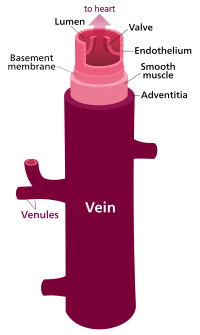
Photo from wikipedia
The adherence and shear-resistance of human umbilical venous endothelial cells (HUVEC) on polymers is determined in vitro in order to qualify cardiovascular implant materials. In these tests, variable fractions of… Click to show full abstract
The adherence and shear-resistance of human umbilical venous endothelial cells (HUVEC) on polymers is determined in vitro in order to qualify cardiovascular implant materials. In these tests, variable fractions of HUVEC do not adhere to the material but remain suspended in the culture medium. Nonadherent HUVEC usually stop growing, rapidly lose their viability and can release mediators able to influence the growth and function of the adherent HUVEC. The aim of this study was the investigation of the time dependent behaviour of HUVEC under controlled nonadherent conditions, in order to gain insights into potential influences of these cells on their surrounding environment in particular adherent HUVEC in the context of in vitro biofunctionality assessment of cardiovascular implant materials. Data from adherent or nonadherent HUVEC growing on polystyrene-based cell adhesive tissue culture plates (TCP) or nonadhesive low attachment plates (LAP) allow to calculate the number of mediators released into the culture medium either from adherent or nonadherent cells. Thus, the source of the inflammatory mediators can be identified. For nonadherent HUVEC, a time-dependent aggregation without further proliferation was observed. The rate of apoptotic/dead HUVEC progressively increased over 90% within two days. Concomitant with distinct blebbing and loss of membrane integrity over time, augmented releases of prostacyclin (PGI2, up to 2.91 ± 0.62 fg/cell) and platelet-derived growth factor BB (PDGF-BB, up to 1.46 ± 0.42 fg/cell) were detected. The study revealed that nonadherent, dying HUVEC released mediators, which can influence the surrounding microenvironment and thereby the results of in vitro biofunctionality assessment of cardiovascular implant materials. Neglecting nonadherent HUVEC bears the risk for under- or overestimation of the materials endothelialization potential, which could lead to the loss of relevant candidates or to uncertainty with regard to their suitability for cardiac applications. One approach to minimize the influence from nonadherent endothelial cells could be their removal shortly after observing initial cell adhesion. However, this would require an individual adaptation of the study design, depending on the properties of the biomaterial used.
Journal Title: International Journal of Molecular Sciences
Year Published: 2021
Link to full text (if available)
Share on Social Media: Sign Up to like & get
recommendations!